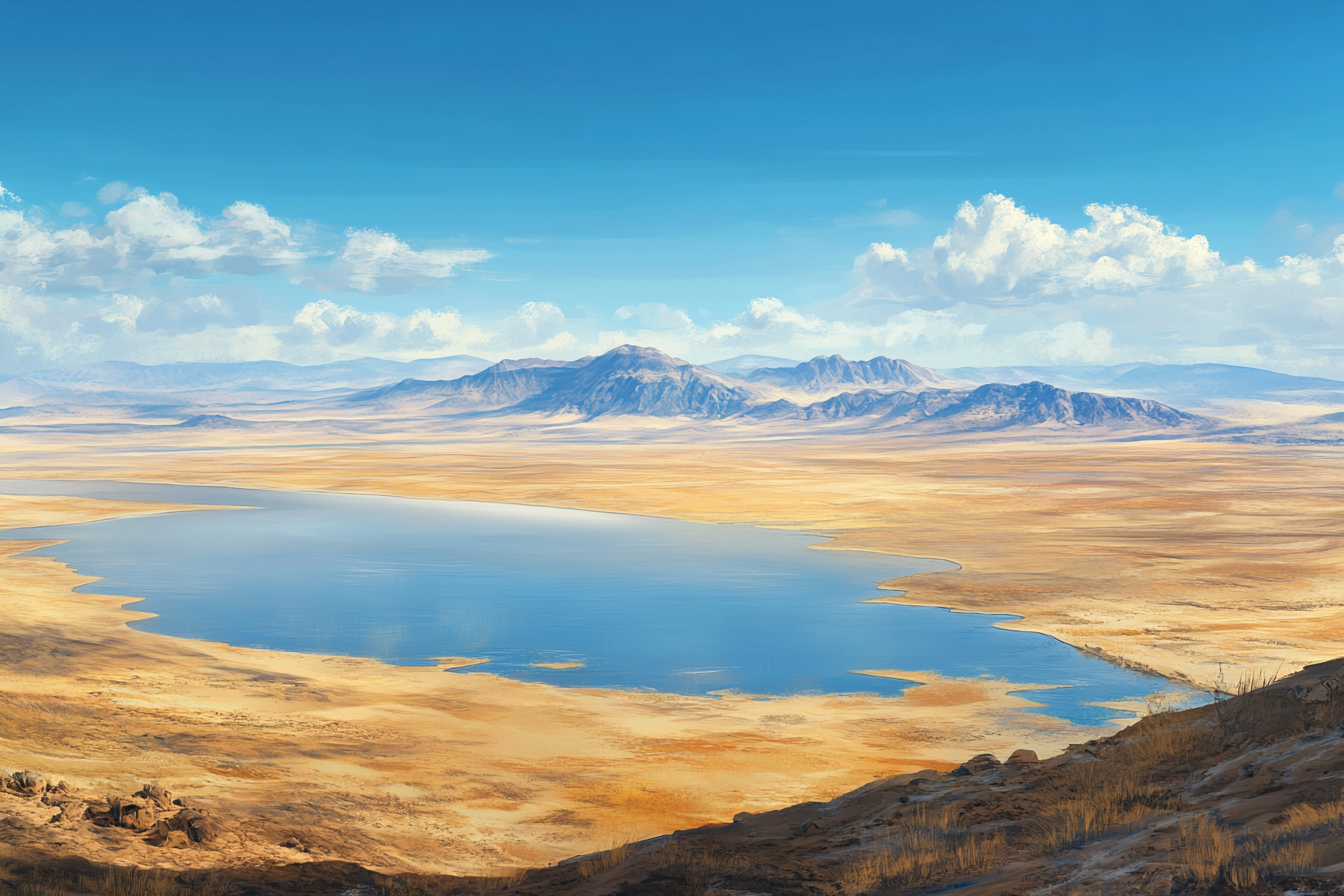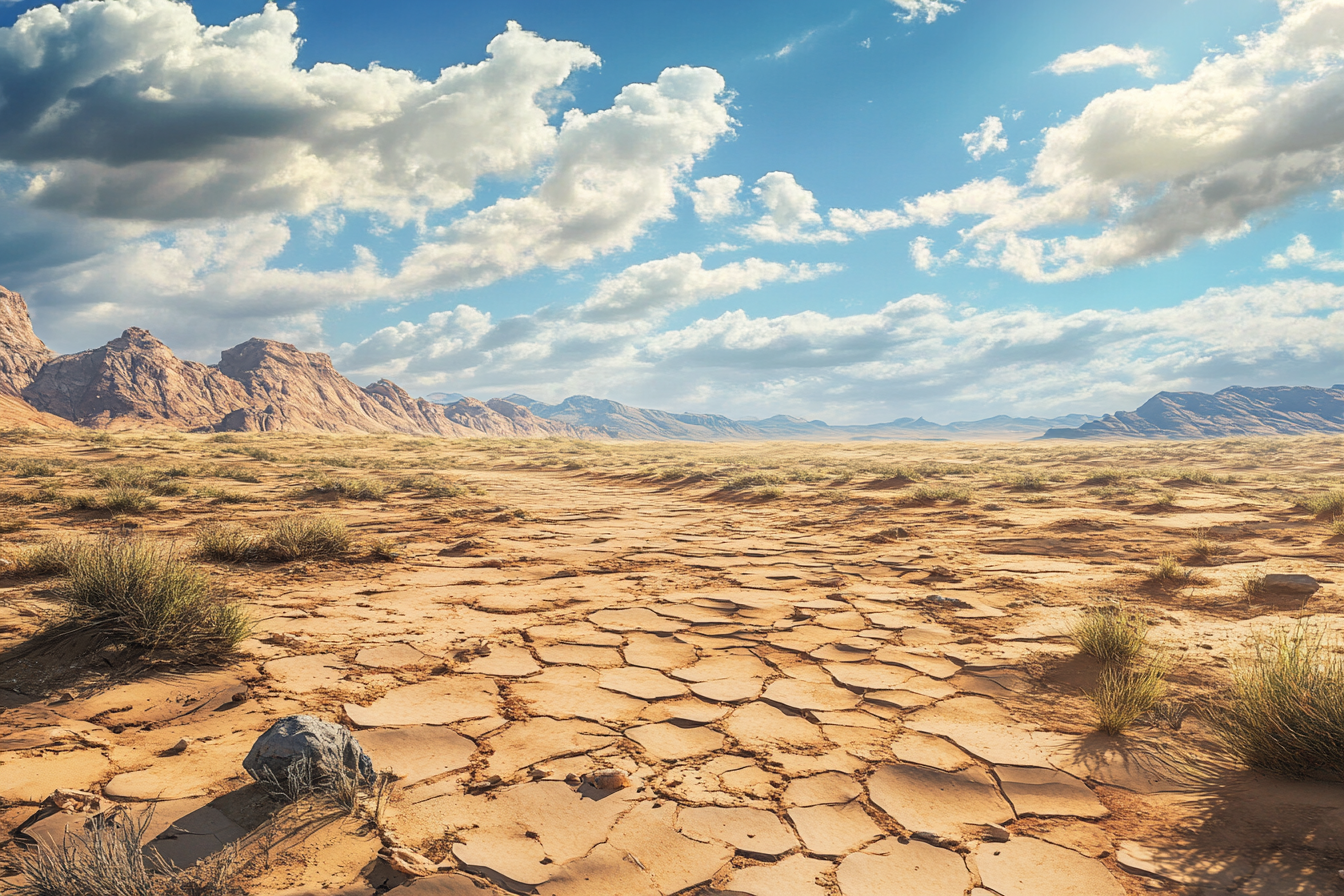Okkthruk Depression
Pronunciation: OKK-thruk
Map Index: F4, G4
Location: Central Beorlan, surrounded by the Kraguk, Kragnuk, and Goraukoros Mountains
Geography: The Okkthruk Depression consists of a vast low area where water flows in from all sides. Bordered by the Kraguk and Kragnuk Mountains in the west and the Goraukoros Mountains in the east, this enormous basin finds itself cut off and isolated from the rest of Beorlan.
Sitting at an elevation of 362 feet below sea level, the lowest point in all of Raios, lies the great lake of Urwaelin. Stretching across the broad valley with its deceptive treacherous waters, this great lake spans nearly 60 miles in length and 20 miles in width. Great salt flats lie on the periphery of the lake in many areas with some covering large areas. With evaporation high in this arid climate, Urwaelin Lake maintains its depth by the large inflow of waters from the surrounding mountains during spring snow melt. On the highest areas, snow often accumulates before it finally melts in the spring. With no outlet to the sea, the salt slowly builds up in the lake waters, resulting in saline water similar to that of the sea. While the scenic lake appears peaceful, perilous hidden creatures lurk beneath the surface, ready to ensnare the unwary.
Primary Population: Skryx
Secondary Population: Fire Goblin
Minor Population: Turoch
Climate: The arid subtropical climate produces sweltering heat in the summer months with little rainfall. What rain that does fall occurs mainly in the moderately hot winter months when a occasional storms drop much needed precipitation. In winter, thunderstorms roll through the nearby mountains, resulting in large amounts of runoff flowing into ephemeral streams that eventually reach the lake.
Wildlife: The upland areas of the Okkthruk Depression look deserted during daylight hours but come nightfall, a variety of nocturnal insects, lizards, snakes, and small mammals emerge once the evening air cools after a sweltering day. A major focal point in the depression remains the lake. Here on the shores, a large variety of birds live, feeding off of the great schools of fish that live in the lake.
Humanoids: The only humanoids to live here year-round are the insect-like Skryx. Digging underground tunnels, they live below the surface during the heat of day and emerge at night to obtain food. Most of the Stryx population remains centered around the ruins of an old city that lie near the foot of the Goraukoros Range. Travelers claim that the Stryx live amongst the ruins, attacking all trespassers who dare enter the area of the old city.
The fire goblins of Gok Grusmak often visit the Okkthruk Depression to collect salt and to catch fish in shallow water areas with their nets.
The Turoch also make brief sojourns into the lakeside area for salt but never stay for very long due to a lack of drinking water.
Monsters: The vicinity of the lake presents great danger due to the presence of a myriad of aberrations and beasts.
Legends of a great long necked aquatic monster that lives in Urwaelin Lake can be heard from many cultures in Beorlan. The fire goblins claim that it spends most of its time underwater and only appears when hungry. It has a large mouth filled with razor sharp teeth and swims swiftly with great fins. It regularly snatches goblins who stray too far into the water while fishing and swallows them whole.
History: In prior ages, the lake was several times larger than what exists today and the lake waters contained far less salt. The pre-cataclysm vegetation consisted of short grasses and drought resistant shrubs. Herds of antelope grazed the land along with much other wildlife.
A thriving medium-sized city, its name now lost to time, once sat on the eastern shores of the lake. The inhabitants lived off of the lake and exported salted fish to the Kishari Empire. This life ended abruptly when devastating earthquakes spawned by the Great Cataclysm destroyed the city, followed by terrible chaos storms sweeping down from the Goraukoros Mountains. As elsewhere, the chaos storms forever corrupted the city’s survivors. The cataclysm shifted weather patterns around the world and locally, the climate became much drier. Lake levels began to drop as less water flowed into the lake. Over time this led to a drastic lowering of lake level, exposing the great salt flats that now surround many parts of Urwaelin Lake. The resulting increase of salinity of the water made them undrinkable by most humanoids.
Today: Many travellers enter into the Okkthruk Depression, mostly to collect salt. The lack of potable drinking water forces quick journeys, as do the dangers that emerge in the cool dark of the night.
Map Index: F4, G4
Location: Central Beorlan, surrounded by the Kraguk, Kragnuk, and Goraukoros Mountains
Geography: The Okkthruk Depression consists of a vast low area where water flows in from all sides. Bordered by the Kraguk and Kragnuk Mountains in the west and the Goraukoros Mountains in the east, this enormous basin finds itself cut off and isolated from the rest of Beorlan.
Sitting at an elevation of 362 feet below sea level, the lowest point in all of Raios, lies the great lake of Urwaelin. Stretching across the broad valley with its deceptive treacherous waters, this great lake spans nearly 60 miles in length and 20 miles in width. Great salt flats lie on the periphery of the lake in many areas with some covering large areas. With evaporation high in this arid climate, Urwaelin Lake maintains its depth by the large inflow of waters from the surrounding mountains during spring snow melt. On the highest areas, snow often accumulates before it finally melts in the spring. With no outlet to the sea, the salt slowly builds up in the lake waters, resulting in saline water similar to that of the sea. While the scenic lake appears peaceful, perilous hidden creatures lurk beneath the surface, ready to ensnare the unwary.
Primary Population: Skryx
Secondary Population: Fire Goblin
Minor Population: Turoch
Climate: The arid subtropical climate produces sweltering heat in the summer months with little rainfall. What rain that does fall occurs mainly in the moderately hot winter months when a occasional storms drop much needed precipitation. In winter, thunderstorms roll through the nearby mountains, resulting in large amounts of runoff flowing into ephemeral streams that eventually reach the lake.
Wildlife: The upland areas of the Okkthruk Depression look deserted during daylight hours but come nightfall, a variety of nocturnal insects, lizards, snakes, and small mammals emerge once the evening air cools after a sweltering day. A major focal point in the depression remains the lake. Here on the shores, a large variety of birds live, feeding off of the great schools of fish that live in the lake.
Humanoids: The only humanoids to live here year-round are the insect-like Skryx. Digging underground tunnels, they live below the surface during the heat of day and emerge at night to obtain food. Most of the Stryx population remains centered around the ruins of an old city that lie near the foot of the Goraukoros Range. Travelers claim that the Stryx live amongst the ruins, attacking all trespassers who dare enter the area of the old city.
The fire goblins of Gok Grusmak often visit the Okkthruk Depression to collect salt and to catch fish in shallow water areas with their nets.
The Turoch also make brief sojourns into the lakeside area for salt but never stay for very long due to a lack of drinking water.
Monsters: The vicinity of the lake presents great danger due to the presence of a myriad of aberrations and beasts.
Legends of a great long necked aquatic monster that lives in Urwaelin Lake can be heard from many cultures in Beorlan. The fire goblins claim that it spends most of its time underwater and only appears when hungry. It has a large mouth filled with razor sharp teeth and swims swiftly with great fins. It regularly snatches goblins who stray too far into the water while fishing and swallows them whole.
History: In prior ages, the lake was several times larger than what exists today and the lake waters contained far less salt. The pre-cataclysm vegetation consisted of short grasses and drought resistant shrubs. Herds of antelope grazed the land along with much other wildlife.
A thriving medium-sized city, its name now lost to time, once sat on the eastern shores of the lake. The inhabitants lived off of the lake and exported salted fish to the Kishari Empire. This life ended abruptly when devastating earthquakes spawned by the Great Cataclysm destroyed the city, followed by terrible chaos storms sweeping down from the Goraukoros Mountains. As elsewhere, the chaos storms forever corrupted the city’s survivors. The cataclysm shifted weather patterns around the world and locally, the climate became much drier. Lake levels began to drop as less water flowed into the lake. Over time this led to a drastic lowering of lake level, exposing the great salt flats that now surround many parts of Urwaelin Lake. The resulting increase of salinity of the water made them undrinkable by most humanoids.
Today: Many travellers enter into the Okkthruk Depression, mostly to collect salt. The lack of potable drinking water forces quick journeys, as do the dangers that emerge in the cool dark of the night.

